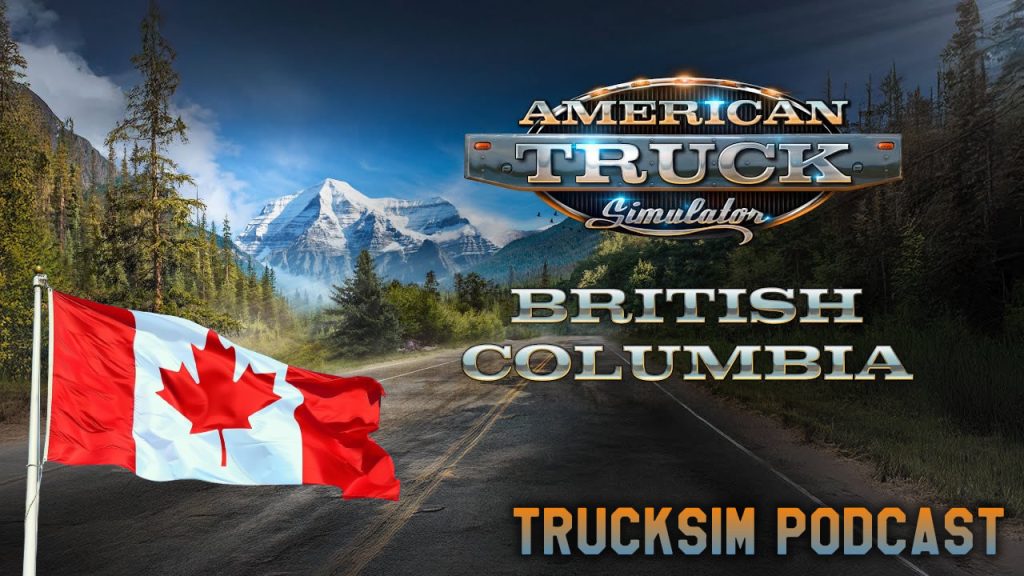American Truck Simulator is going to Canada in 2026-2027 and I did a podcast about it.
The Painting Livestream Announcement
So, picture this: SCS Software goes live on their channel, and instead of the usual gameplay footage or developer interview, there’s just… someone painting. Like, actual brush-on-canvas painting. No explanation, no commentary at first – just art.
The community immediately went into speculation mode. Chat was going crazy trying to figure out what was happening. As the painting developed, you started seeing these massive mountains, dense forests, and this absolutely stunning natural landscape taking shape.
And then it clicked for people – those aren’t just any mountains. That’s the Pacific Northwest. That’s British Columbia.

What made this announcement so brilliant was how perfectly it captured the essence of what BC is known for – its breathtaking natural beauty. Instead of just dropping a trailer, SCS turned the announcement into an experience. The painting itself became a piece of art that represented the region, and watching it come together in real-time mirrored the excitement of watching the DLC itself take shape.
The community loved it. People were simultaneously trying to guess the location, celebrating that ATS was finally crossing the border, and just appreciating the artistic approach. It set the tone perfectly – this wasn’t just another map expansion, this was something special.
Breaking New Ground: ATS Goes International
Now, let’s talk about the elephant in the room – or should I say, the moose in the room? American Truck Simulator was going to Canada. This might not sound like a huge deal at first, but it represented a massive shift for the game and came with some serious challenges.
Challenge #1: The Border Crossing
First and most obviously – how do you handle an international border? This isn’t like crossing from California into Nevada. There are customs, border checkpoints, different regulations. SCS had to decide how much realism to include without making it tedious for players. Do you simulate the whole border crossing experience? Do you simplify it? It’s a delicate balance between authenticity and gameplay.
Challenge #2: Standards and Systems
Here’s where it gets technical. Canada uses the metric system. Road signs are in kilometers, not miles. Speed limits are km/h, not mph. Weight restrictions are in kilograms and tonnes, not pounds and tons.
Then there are the road signs themselves – Canadian signage looks different from US signage. The design language, the symbols, the colors – they all have to be authentic. SCS is known for their attention to detail, so they couldn’t just slap different numbers on American signs and call it a day.
Traffic laws also differ. British Columbia has its own provincial regulations, road rules, and highway systems that don’t exactly match what American truckers deal with.
Challenge #3: Geography and Scale
British Columbia is HUGE. We’re talking about a province that’s bigger than many US states, with incredibly diverse geography. You’ve got the Pacific coastline, the Rocky Mountains, temperate rainforests, interior plateaus, and vast wilderness areas.
Capturing that variety while maintaining the game’s map scale is no small feat. How do you represent the Sea-to-Sky Highway’s dramatic elevation changes? How do you do justice to the Fraser Canyon? These are some of the most spectacular driving roads in North America, and they had to translate into the game in a way that felt authentic but was still drivable and fun.
Challenge #4: Research and Reference Material
Developing a map of US states is one thing – SCS is based in the Czech Republic, but the US has extensive street view coverage, tons of reference photos, and plenty of accessible information.
But expanding to a new country means building relationships with new government agencies, tourism boards, and local experts. They needed permission to use landmarks, accurate data for road layouts, and cultural consultants to make sure everything felt genuinely Canadian, not just “America with different signs.”
Challenge #5: The Name Itself
There’s even a philosophical question here: Is it still “American Truck Simulator” when you’re driving through Canada? Some in the community joked that it should be renamed “North American Truck Simulator.” But ATS is a brand at this point, and the expansion shows that the vision for the game has always been bigger than just the United States.
Why British Columbia Was the Perfect Choice
Despite these challenges – or maybe because of them – British Columbia was actually the ideal first Canadian province for ATS.
Geographically, it shares a border with Washington state, which was already in the game. This made integration more natural than, say, jumping straight to Ontario.
BC is also a major economic region with strong trade connections to the US, especially through ports like Vancouver. Trucking between BC and Washington is a real, vital industry, so it made sense from a gameplay and realism perspective.
And let’s be honest – British Columbia is absolutely gorgeous. Those mountain highways, coastal routes, and forest roads are bucket-list drives for real truckers. It was an opportunity for SCS to showcase some truly spectacular scenery.
What This Means for ATS’s Future
The British Columbia DLC wasn’t just about adding one more region to the map. It was proof of concept that ATS could expand beyond its original scope. It opened the door for future Canadian provinces – Alberta, Saskatchewan, Manitoba, Ontario – and showed that the game’s vision could encompass the entire continent.
It also demonstrated SCS Software’s commitment to authenticity. They didn’t take the easy route. They put in the work to make Canada feel like Canada, not just “snow America.”